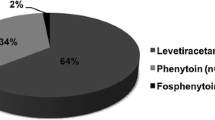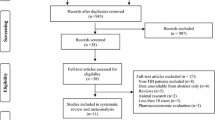Abstract
Introduction
Pharmacological prophylaxis for early seizures following traumatic brain injury (TBI) is a recommendation in the Brain Trauma Foundation Guidelines. However, several studies have challenged the efficacy and safety of this practice, resulting in varied practice across centers around the world. The purpose of the present study was to compare the incidence of early clinical seizures following TBI, between two large centers, a US Center that practises routine seizure prophylaxis and a Chinese Center that does not use seizure prophylaxis following TBI.
Patients and methods
This was a prospective observational study including an urban level I trauma center in the USA and a large hospital in Shenzhen, China. At the US Center, all patients received seizure prophylaxis with levetiracetam. At the Chinese Center, no seizure prophylaxis was given. All patients with blunt TBI and positive computed tomography findings for epidural hematoma, subdural hematoma, subarachnoid hemorrhage, intracerebral hemorrhage or diffuse axonal injury were included. Patients who died within 24 h of admission were excluded. The study population was monitored daily for clinical seizures for the first 7 post-injury days. Data collected included demographics, mechanism of injury, vital signs upon arrival, injury severity and emergency interventions. Primary outcome was the incidence of early seizures, defined as those occurring within 7 days of injury.
Results
A total of 522 patients were included in the analysis: 272 patients at the US Center who received seizure prophylaxis and 250 patients at the Chinese Center who did not receive prophylaxis. Overall, 3.7% of patients who received seizure prophylaxis developed early seizures, compared to 2.8% of patients who did not receive any prophylaxis (p = 0.573). Decompressive craniectomy was associated with the highest incidence of early seizure (9.2%). In this subgroup, the seizure rate was 10.4% in the prophylaxis group and 7.1% in the no-prophylaxis group (p = 0.738). Patients with admission GCS < 9 had an overall early seizure incidence of 7.0%: 4.3% in the prophylaxis group and 14.3% in the no-prophylaxis group (p = 0.062). Analysis of the subgroup with isolated blunt TBI showed an incidence of early seizures of 3.4% in the prophylaxis group versus 2.4% in the no-prophylaxis group (p = 0.593). Further analyses of outcomes according to head AIS 3, 4 and 5 showed no significant difference in the seizure rate between the two groups: head AIS 3: 6.1% in the prophylaxis group versus 2.6% in the no-prophylaxis group, p = 0.329; head AIS 4: 0 versus 2.7%, p = 0.302; head AIS 5: 8.7 versus 4.0%, p = 0.601.
Conclusions
The present study failed to show any benefit of routine early seizure prophylaxis following blunt TBI. This practice should be reexamined in a large randomized clinical study.
Similar content being viewed by others
References
Carney N, Totten AM, O’Reilly C, Ullman JS, Hawryluk GW, Bell MJ et al (2017) Guidelines for the management of severe traumatic brain injury, fourth edition. Neurosurgery 80:6–15
Temkin NR, Dikmen SS, Wilensky AJ, Keihm J, Chabal S, Winn HR (1990) A randomized, double-blind study of phenytoin for the prevention of post-traumatic seizures. N Engl J Med 323:497–502
Bhullar IS, Johnson D, Paul JP, Kerwin AJ, Tepas JJ 3rd, Frykberg ER (2014) More harm than good: antiseizure prophylaxis after traumatic brain injury does not decrease seizure rates but may inhibit functional recovery. J Trauma Acute Care Surg 76:54–60 discussion 60-51
Dikmen SS, Machamer JE, Winn HR, Anderson GD, Temkin NR (2000) Neuropsychological effects of valproate in traumatic brain injury: a randomized trial. Neurology 54:895–902
Dikmen SS, Temkin NR, Miller B, Machamer J, Winn HR (1991) Neurobehavioral effects of phenytoin prophylaxis of posttraumatic seizures. JAMA 265:1271–1277
Young B, Rapp RP, Norton JA, Haack D, Tibbs PA, Bean JR (1983) Failure of prophylactically administered phenytoin to prevent early posttraumatic seizures. J Neurosurg 58:231–235
Gennarelli TA, Wodzin E (eds) (2005) AIS 2005. Association for the Advancement of Automotive Medicine, Barrington
Hung C, Chen JW (2012) Treatment of post-traumatic epilepsy. Curr Treat Options Neurol 14(4):293–306
Szaflarski JP, Nazzal Y, Dreer LE (2014) Post-traumatic epilepsy: current and emerging treatment options. Neuropsychiatr Dis Treat. 11(10):1469–1477
Chung MG, O’Brien NF (2016) Prevalence of early posttraumatic seizures in children with moderate to severe traumatic brain injury despite levetiracetam prophylaxis. Pediatr Crit Care Med 17:150–156
Cranley MR, Craner M, McGilloway E (2016) Antiepileptic prophylaxis following severe traumatic brain injury within a military cohort. J R Army Med Corps 162:109–114
Frey LC (2003) Epidemiology of posttraumatic epilepsy: a critical review. Epilepsia 44(Suppl 10):11–17
Won SY, Konczalla J, Dubinski D, Cattani A, Cuca C, Seifert V et al (2017) A systematic review of epileptic seizures in adults with subdural haematomas. Seizure 45:28–35
Zangbar B, Khalil M, Gruessner A, Joseph B, Friese R, Kulvatunyou N et al (2016) Levetiracetam prophylaxis for post-traumatic brain injury seizures is ineffective: a propensity score analysis. World J Surg 40:2667–2672. https://doi.org/10.1007/s00268-016-3606-y
Debenham S, Sabit B, Saluja RS, Lamoureux J, Bajsarowicz P, Maleki M et al (2011) A critical look at phenytoin use for early post-traumatic seizure prophylaxis. Can J Neurol Sci 38:896–901
Ritter AC, Wagner AK, Fabio A, Pugh MJ, Walker WC, Szaflarski JP et al (2016) Incidence and risk factors of posttraumatic seizures following traumatic brain injury: a traumatic brain injury model systems study. Epilepsia 57:1968–1977
Inaba K, Menaker J, Branco BC, Gooch J, Okoye OT, Herrold J et al (2013) A prospective multicenter comparison of levetiracetam versus phenytoin for early posttraumatic seizure prophylaxis. J Trauma Acute Care Surg 74:766–771 discussion 771-763
Szaflarski JP, Sangha KS, Lindsell CJ, Shutter LA (2010) Prospective, randomized, single-blinded comparative trial of intravenous levetiracetam versus phenytoin for seizure prophylaxis. Neurocrit Care 12:165–172
Yang Y, Zheng F, Xu X, Wang X (2016) Levetiracetam versus phenytoin for seizure prophylaxis following traumatic brain injury: a systematic review and meta-analysis. CNS Drugs 30:677–688
Dauch WA, Schutze M, Guttinger M, Bauer BL (1996) Post-traumatic seizure prevention–results of a survey of 127 neurosurgery clinics. Zentralbl Neurochir 57:190–195
Jacka MJ, Zygun D (2007) Survey of management of severe head injury in Canada. Can J Neurol Sci 34:307–312
Ritter AC, Wagner AK, Szaflarski JP, Brooks MM, Zafonte RD, Pugh MJ et al (2016) Prognostic models for predicting posttraumatic seizures during acute hospitalization, and at 1 and 2 years following traumatic brain injury. Epilepsia 57(9):1503–1514
Aiolfi A, Benjamin E, Khor D, Inaba K, Lam L, Demetriades D (2017) Brain trauma foundation guidelines for intracranial pressure monitoring: compliance and effect on outcome. World J Surg 41:1543–1549. https://doi.org/10.1007/s00268-017-3898-6
Author information
Authors and Affiliations
Corresponding author
Ethics declarations
Conflict of interest
All authors deny any potential conflicts of interest.
Rights and permissions
About this article
Cite this article
Khor, D., Wu, J., Hong, Q. et al. Early Seizure Prophylaxis in Traumatic Brain Injuries Revisited: A Prospective Observational Study. World J Surg 42, 1727–1732 (2018). https://doi.org/10.1007/s00268-017-4373-0
Published:
Issue Date:
DOI: https://doi.org/10.1007/s00268-017-4373-0




